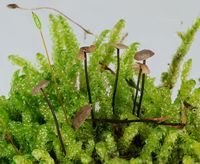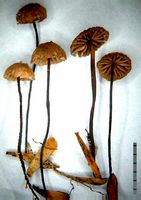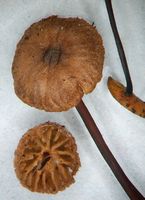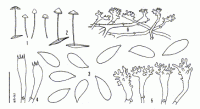|
 Marasmius kanukaneus Marasmius kanukaneus
SynonymsCollybiopsis kanukanea
Marasmius tasmaniensis
BiostatusPresent in region - Indigenous. Non endemic
Images (click to enlarge)
Owner: J.A. Cooper | 
Owner: J.A. Cooper | 
Owner: J.A. Cooper |  | 
Caption: Fig. 22 (1-6). Marasmius kanukaneus G. Stevenson (ZT 68-469).- 1. Basidiomes.- 2. Basidiomes
(x2).- 3. Basidiospores.- 4. Basidia.- 5. Cheilocystidia.- 6. Pileipellis. |
Article: Horak, E. (1971). A contribution towards the revision of the Agaricales (Fungi) from New Zealand. New Zealand Journal of Botany 9(3): 403-462 (http://www.rsnz.org/publish/abstracts.php).
Notes: Marasmius kanukaneus Stevenson (29 D) = Collybiopsis kanukanea (Stevenson)
comb. nov. (Basionym: M. kanukaneus Stevenson, Kew Bull. 19: 36, 1964)
Article: Stevenson, G. (1964). The Agaricales of New Zealand: V. Kew Bulletin 19(1): 1-59.
Description: Pileus 1-3 mm diam., lilac grey, velvety, plano-convex. Gills adnexed, white with pink tinge, distant. Stipe 1.5-2 cm x 0.5 mm, dark purplish brown, polished, tough. Spores 7-8 x 4 µm, non-amyloid, hyaline. Cuticle of loosely woven, amyloid to pseudo-amyloid hyphae, some with irregular thickenings, with broom-cell-like endings (Fig. 17).
Habitat: Inserted on fallen leaves of Leptospermum ericoides, Puramahoi, Nelson, 20.4.1955, Dorothy Read in Stevenson (type).
Article: Desjardin, D.E.; Horak, E. (1997). Marasmius and Gloiocephala in the South Pacific Region: Papua New Guinea, New Caledonia, and New Zealand taxa. Bibliotheca Mycologica 168: 152 p.
Description: Pileus 2-5 mm diam, hemispherical to convex when young, expanding with age to plano-convex
with a flat to depressed disc, with or without a inconspicuous conical papilla; margin decurved,
plicate; surface dull, dry, glabrous to minutely pruinose; disc greyish lilac, sooty brown or dark
brown, becoming beige with pale reddish brown tones towards the margin. Texture tough,
membranaceous; context thin, buff.- Lamellae adnexed, close to subdistant (9-11) with 1-2 series of
lamellulae, noncollariate or seldom with a pseudocollarium, buff, beige or pale brown with reddish
tone; edges fimbriate, concolorous.- Stipe 10-30 x 0.3-0.5 mm, central, cylindrical, equal, wiry,
tough, glabrous, insititious; apex pale brown, blackish brown elsewhere; black rhizomorphs
present.- Odor and taste not distinctive.
Basidiospores 6-9 x 2.5-3.5 µm, narrowly ellipsoid, smooth, thin-walled, hyaline, inamyloid,
Basidia 17-24 x 5-6 µm, subclavate, 4-spored, clamped.- Cheilocystidia 12-25 x 5-8 µm ,
subclavate, seldom lobate, apically diverticulate, hyaline, thin-walled; diverticula 2-5 x 1.0-1.5 µm,
cylindrical to irregular in outline, seldom forked, hyaline.- Pleurocystidia absent.- Pileipellis
subhymeniform on the disc, a loose Rameales-structure on the margin, with diverticulate terminal
cells; main body of terminal cells 1535 x 5-10 µm, clavate or irregular in outline, sometimes lobed,
hyaline; diverticula 1-4 x 1.0-1.5 µm, cylindrical to irregular in outline, seldom forked, hyaline;
subtending cells and subcuticular hyphae with pale brown pigment incrustations, non-gelatinous.-
Pileal and lamellar trama hyphae inamyloid.- Stipe tissue monomitic; cortical hyphae smooth to
roughened, some pigment-incrusted, brown, dextrinoid; medullary hyphae hyaline, inamyloid to
dextrinoid.- Caulocystidia absent.- Clamp connectins present.
Habitat: Habit, habitat and distribution.- Solitary, on fallen leaves of Kunzea (Leptospermum) ericoides
(Holotype), Leptospermum scoparium (Myrtaceae) or Dacrydium bidwilli (Podocarpaceae), or on
Nothofagus fusca (Fagaceae) or Quintinia sp. (Escalloniaceae). New Zealand, Tasmania.
Notes: Marasmius kanukaneus produces basidiomes on a number of different substrates. The holotype
specimen was collected on leaves of Leptospermum and we have collected several other specimens
on this substrate. Specimens have also been collected on Dacrydium, Nothofagus and Quintinia.
We can find no significant differences between M. kanukaneus and M. tasmaniensis Singer
(1989), a species described recently from material collected on Nothofagus leaves in Tasmania and
we consider the two species conspecific (Holotype of M. tasmaniensis, F!).
Like M. rimuphilus, M. kanukaneus may have been the species reported from New Zealand as M.
androsaceus by Colenso (1886). Marasmius androsaceus differs primarily in forming broader
basidiospores (3.5-5.0 µm), and more deeply pigment and densely incrusted pileipellis hyphae. The
latter temperate Northern Hemisphere morphospecies is actually a complex of
macromorphologically indistinguishable taxa, differing in culture morphology (Desjardin, 1990),
mating compatibility (S. Gordon, unpubl. data), and molecular sequence (Desjardin, unpubl. data).
Until more research is conducted on this confusing group, we prefer to retain M. kanukaneus as
distinct from phenetically similar taxa.
|